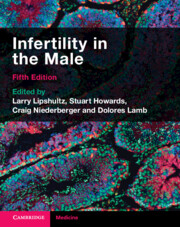Book contents
- Infertility in the Male
- Infertility in the Male
- Copyright page
- Contents
- Contributors
- Foreword
- Abbreviations
- Introduction
- Section 1 Scientific Foundations of Male Infertility
- Section 2 Clinical Evaluation of the Infertile Male
- Chapter 7 Infertility as a Metric of Men’s Health
- Chapter 8 Office Evaluation of the Subfertile Male
- Chapter 9 Evaluation of the Infertile Male’s Partner
- Chapter 10 Imaging the Male Reproductive System
- Chapter 11 Effects of Environmental Chemicals on Male Reproduction
- Chapter 12 Endocrine Causes of Male Infertility – Diagnosis and Treatment
- Chapter 13 Spermatogenesis – Diagnosis of Normal and Abnormal States
- Chapter 14 Inheritance and Male Fertility
- Chapter 15 The Varicocele – Approaches to Diagnosis and Management
- Chapter 16 Infection, Inflammation, and Immunological Causes of Male Infertility
- Section 3 Laboratory Diagnosis of Male Infertility
- Section 4 Treatment of Male Infertility
- Section 5 Health Care Systems and Culture
- Index
- References
Chapter 11 - Effects of Environmental Chemicals on Male Reproduction
from Section 2 - Clinical Evaluation of the Infertile Male
Published online by Cambridge University Press: 08 July 2023
- Infertility in the Male
- Infertility in the Male
- Copyright page
- Contents
- Contributors
- Foreword
- Abbreviations
- Introduction
- Section 1 Scientific Foundations of Male Infertility
- Section 2 Clinical Evaluation of the Infertile Male
- Chapter 7 Infertility as a Metric of Men’s Health
- Chapter 8 Office Evaluation of the Subfertile Male
- Chapter 9 Evaluation of the Infertile Male’s Partner
- Chapter 10 Imaging the Male Reproductive System
- Chapter 11 Effects of Environmental Chemicals on Male Reproduction
- Chapter 12 Endocrine Causes of Male Infertility – Diagnosis and Treatment
- Chapter 13 Spermatogenesis – Diagnosis of Normal and Abnormal States
- Chapter 14 Inheritance and Male Fertility
- Chapter 15 The Varicocele – Approaches to Diagnosis and Management
- Chapter 16 Infection, Inflammation, and Immunological Causes of Male Infertility
- Section 3 Laboratory Diagnosis of Male Infertility
- Section 4 Treatment of Male Infertility
- Section 5 Health Care Systems and Culture
- Index
- References
Summary
The potential for chemicals and toxicants to adversely impact health and reproduction is not a new concern; it dates back to biblical times, ancient Egypt, Greece, and the Roman Empire [1, 2]. However, it was not until the middle of the twentieth century that concerns about the effects of chemicals on reproduction were raised. In 1962, Rachel Carlson published her landmark book The Silent Spring, in which she described the harmful effects of pesticides on wildlife reproduction [3]. She is credited with starting the environmental movement, leading to the establishment of the National Institute of Environmental Health Sciences (NIEHS) in 1966 [4] and the National Institute for Occupational Safety and Health (NIOSH) in 1970 [5]. The mission of the NIEHS is to “discover how the environment affects people, in order to promote healthier lives and to provide global leadership for innovative research that improves public health by preventing disease and disability.” The mission of NIOSH is to “generate new knowledge in the field of occupational safety and health and to transfer that knowledge into practice for the betterment of workers.” Through the stewardship of these agencies, as well as those in Europe and the World Health Organization (WHO), research in the fields of occupational and environmental effects on reproduction has dramatically increased [6–8]. Nonetheless, relatively few of the thousands of chemicals used in the workplace or as ingredients in commonly used products, or identified in the environment (air, water, earth, and food), have been examined for their effects on reproductive function. Of those chemicals that have been studied, few have been definitively shown to induce reproductive toxicity.
- Type
- Chapter
- Information
- Infertility in the Male , pp. 182 - 196Publisher: Cambridge University PressPrint publication year: 2023



